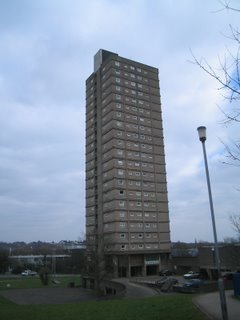Who lives in a place like this?

James Howard Kunstler has a new essay up on his site called "A Reflection on Cities of the Future". While it offers little new information to those already familiar with Kunstler's work - I found it engaging personally as it made me revisit some of my own thoughts about buildings, urban planning and modernism in general.
I come from an intellectual tradition that privileges 'modernism' as an artistic highpoint in Western culture and perhaps the last cohesive moment before a descent into chaos. On the obverse to this, I percieve the culture of 'modernism' equating with the culture that produced the total wars and unsustainable economics of the Twentieth Century. I am also excited by the polymorphous play and freedom of the cultural moment that is post - 'modernism' (if not necessarily postmodernist). The issue is, for me - and I suspect many others, further problematised by an inherent sense that novelty is revolutionary, smashing old decadent traditions - and thus a largely unquestioned faith in an 'avant-garde' or cultural vanguard - leading to a preference for 'new' or 'modern' things that can easily and confusingly be considered a 'modernist' attitude.
You still with me? Now the built environment is an excellent locus for exploring one's feelings about the 'modern' and 'modernism' - because this is where these ideas can be seen to directly impinge on our existence. We can clearly see when ideas are realised in ways that are successful, and when they are not. 'Modernism' in architecture is revealed as a broad church that contains both high ideals and base forms.
It is therefore not as simple as being pro or anti the 'modernist' vision, each example must be taken first on its own merits - and subsequent to this, we might draw more general conclusions. Do the 1930s skyscraper and the 1960s tower block have less in common or more in common than we first imagine? Can the obvious faults of an unsuccesful realisation provide us with an insight into unseen failings in apparently successful realisations - and vice versa? Can we learn from our mistakes? While part of me is caught up in the shiny surfaced sci-fi dream of the skyscraper, the cool lines glass, concrete and steel of empty cubes in minimal houses and apartments – another part is close to
While part of me is caught up in the shiny surfaced sci-fi dream of the skyscraper, the cool lines glass, concrete and steel of empty cubes in minimal houses and apartments – another part is close to the earth, wrapped in a fantasy of organic architecture blending into the landscape, curvilinear and irregular natural materials. Is this the age old dichotomy - town & country, urban vs rural, nature versus culture, Narziss und Goldmund - is it anything to do with youth versus age, or are these too false distinctions? Why do the 'clean' lines of modernist architecture so often seem to require materials which are 'dirty' - polluting (cement/concrete), and environmentally destructive (all the quarried marbles etc.)? How futuristic is a building style that not only has no future, but may be partly responsible for destroying the future?
the earth, wrapped in a fantasy of organic architecture blending into the landscape, curvilinear and irregular natural materials. Is this the age old dichotomy - town & country, urban vs rural, nature versus culture, Narziss und Goldmund - is it anything to do with youth versus age, or are these too false distinctions? Why do the 'clean' lines of modernist architecture so often seem to require materials which are 'dirty' - polluting (cement/concrete), and environmentally destructive (all the quarried marbles etc.)? How futuristic is a building style that not only has no future, but may be partly responsible for destroying the future?
I really don’t know enough about the New Urbanist movement to make a decent comment on it. I’ve read some of what Kunstler has said about it, heard interviews with Richard Register – and it sounds like there are great ideas in there. But always at my back of my mind is the fear of how the best ideas can be debased. Just as the grand visions of modernism were too often transformed into cheap imitations that both failed to realise the modernist ambition at their root and were significantly worse than what they replaced. When I read or hear about the New Urbanist vision, two examples come to mind that seem to bear much resemblance to what is being talked about, and which I find personally distasteful. The first is where I grew up, and where I find myself residing again,  South Woodham Ferrers in the county of Essex in the South East of the UK. This village become town which trebled in size while I was at school was extensively remodelled over that time to move from being merely a commuter dormitory town to somewhere with genuine community. This project (“South Woodham Ferrers – the Place to Be” - apparently) involved building an entirely new town centre from scratch – with town square, faux-medieval pedestrian shopping alleys, church, school, library, supermarket (complete with fake dovecote roof), pub (a new build made to appear to be an agricultural building converted into a pub – with old ploughs etc on the wall for “authenticity”) and later a bandstand in the town square. It was an abject failure, few shops manage to last very long, the land is owned by the superstore (Asda/WalMart) who control the rents and can thus easily destroy any competition, the civic space is largely un-used – except by bored youth, and even their recuperation of the space for graffiti, skateboarding, casual drug use, public drunkenness and fighting has been broken by the introduction of ominous CCTV mounted on gargantuan poles. The paved streets and squares are in disrepair.
South Woodham Ferrers in the county of Essex in the South East of the UK. This village become town which trebled in size while I was at school was extensively remodelled over that time to move from being merely a commuter dormitory town to somewhere with genuine community. This project (“South Woodham Ferrers – the Place to Be” - apparently) involved building an entirely new town centre from scratch – with town square, faux-medieval pedestrian shopping alleys, church, school, library, supermarket (complete with fake dovecote roof), pub (a new build made to appear to be an agricultural building converted into a pub – with old ploughs etc on the wall for “authenticity”) and later a bandstand in the town square. It was an abject failure, few shops manage to last very long, the land is owned by the superstore (Asda/WalMart) who control the rents and can thus easily destroy any competition, the civic space is largely un-used – except by bored youth, and even their recuperation of the space for graffiti, skateboarding, casual drug use, public drunkenness and fighting has been broken by the introduction of ominous CCTV mounted on gargantuan poles. The paved streets and squares are in disrepair.
More successful on its own terms, but perhaps even more monitored is the second example – Celebration, Florida, the famed town built by the Walt Disney corporation – not as a theme park, but as a safe, pleasant place for middle class white people to live in a fantasy of the world before rampant capitalism destroyed true communities. This doesn't so much seem to be part of some cohesive vision of a sustainable future for our cities, and a way of rebuilding true communities - as much as a way for the privileged to externalise all the products of the existence they live which they don't like and purchase 'community' as just another commodity.
even more monitored is the second example – Celebration, Florida, the famed town built by the Walt Disney corporation – not as a theme park, but as a safe, pleasant place for middle class white people to live in a fantasy of the world before rampant capitalism destroyed true communities. This doesn't so much seem to be part of some cohesive vision of a sustainable future for our cities, and a way of rebuilding true communities - as much as a way for the privileged to externalise all the products of the existence they live which they don't like and purchase 'community' as just another commodity.
IMAGES: Chrysler Building in New York, USA (William Van Alen), Tudor Road Tower Block in Cwmbran, Wales, UK (unknown), Barcelona Pavilion in Barcelona, Spain (Mies Van Der Rohe), Cover of 'The Hand-Sculpted House' by Ianto Evans, Town Square: South Woodham Ferrers, Essex, UK, Town Square: Celebration, Florida, USA.

2 comments:
I too reside in SWF, I'd love to escape and go somewhere more diverse. I don't fit in with the gym bunny, 4x4 driving, nail appointment keeping peers that surround me as a stay at home Mum.
However I'm strangely attached to the empty place, I don't know why. I guess I just don't know any different. Have you seen the survey results, 600 odd comments on how we hate Asda's dominance.
Thanks Tracy, I think those survey results reveal a depth of feeling, I'd felt was missing in the apathetic masses, turns out that was just my bigoted view!
I've just made my escape from SWF again - but left most of my stuff there with family, so for that (the stuff) and them (the family) I'll be back again soon enough.
I did actually get to appreciate some of the things I originally liked about the place during this recent return. You don't have to walk too far out of toytown to get into some pleasant enough country - something I'm bound to appreciate now I'm living in London again!
Post a Comment